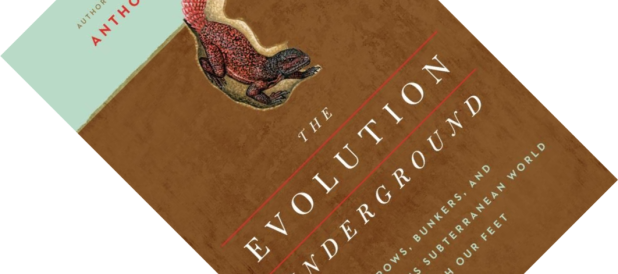An underground lair… what child didn’t daydream about it? As a child, I spent several summer holidays with friends constructing one. Granted, we didn’t really burrow, we dug a pit and put a roof back over it. Even so, if I am to believe Anthony J. Martin, I am but one in a long line of burrowing animals. With The Evolution Underground, Martin paints a surprising picture of the underrated role that burrowing has played throughout evolutionary history.

“The Evolution Underground: Burrows, Bunkers, and the Marvelous Subterranean World Beneath Our Feet“, written by Anthony J. Martin, published by Pegasus Books in February 2017 (hardback) and March 2018 (paperback) – 405 pages
Martin is an ichnologist, a specialist studying fossil traces of behaviour such as footprints, something about which he wrote previously in Dinosaurs Without Bones. Burrows are another kind of trace fossil. After a short introduction into the history of humans and their underground dwellings (from subterranean cities in Turkey that are thousands of years old, to contemporary nuclear bunker complexes), this book is a ride back in time. Burrowing is a surprisingly common behaviour, insects do it, reptiles do it, birds, mammals… pretty much every major group has representatives that dig underground, whether to live there on a permanent basis, to hibernate, or raise young in a safe environment. The advantages are many; other than shelter from predators it is a way to ride out unfavourable seasonal weather, as burrows stay cool in summer and warm in winter. And, as Martin argues, burrows dramatically shift the odds of surviving mass extinctions (see my review of The Ends of The World for a good introduction on the Big Five). It seems that animal lineages with burrowers have time and again lived through times of upheaval, as exemplified by our mammal lineage that is still here after the K-T mass extinction. The observations of pocket gophers that, within days of the volcanic eruption that ripped apart Mount St. Helens in 1980, re-surfaced amidst the debris are astounding.
“[…] burrowing animals are an ecological force that have terraformed the planet.”
But burrowing also has had enormous ecological implications. Martin describes how scientists have traced the first burrowing back all the way to the Ediacaran Period, 630-545 million years ago, when the seas were ruled by microbial films called biomats. Once organisms developed ways of penetrating biomats and the underlying sediment, things would never be the same again. Burrowing has come to play a large, but largely underappreciated role in changing the composition of soils, both on land and underwater, and Martin provides plenty of examples throughout this book. The amounts of sediment that animal groups collectively turn over, dig up, aerate, bioturbate etc. beggar belief. It is safe to say that burrowing animals are an ecological force that have terraformed the planet. Finally, no animal burrows alone. Apart from other species profiting from abandoned burrows on an ad-hoc basis, burrows are microcosms unto themselves with unique communities of smaller organisms living in burrows or constructing their own tunnel systems branching off from them.
Packed with solid information, incredible anecdotes and many subterranean puns and pop-culture references, The Evolution Underground is a joy to read, and, judging by the irreverent glee shining through in Martin’s style, must have been a joy to write. Attractive colour plate sections illuminate the book further. This is a great work of popular science that seems to have largely flown under people’s radar. I am certainly going to pick up his previous book.
Disclosure: The publisher provided a review copy of this book. The opinion expressed here is my own, however.

, hardback or ebook
Other recommended books mentioned in this review:



8 comments